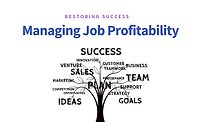Many in our industry feel the strain of increased operational and/or overhead costs that our current operating environment demands: insurance coverages, software, administrative needs, infrastructure, fuel, to name a few. It is a time where it is critical to use company resources as efficiently and effectively as possible to sustain a financially healthy organization without sacrificing quality and service.
Every so often I have the opportunity to engage with experts like my friend Mark Warner, Senior Training Specialist for ISSA’s Cleaning Management Institute. During a conversation last week, he started telling me about their time studies: How long does it take to effectively and efficiently clean a bathroom? A passionate conversation with Mark typically involves words like cross contamination, disinfecting, training, processes, efficiency, quality, and so on … all my favorite things! I could barely keep up with my thoughts as I soaked in his knowledge and began to consider all the ways it can benefit a restoration company.
Over the years, I have had the opportunity to engage with experts from other industries and gain insight on their technology, processes, equipment, and products. It is amazing, when we consider their applications and approaches, the potential impact on our effectiveness, efficiency, and profitability. Simply looking a bit outside of our industry you may find a wealth of resources available to us that could benefit our restoration companies in many ways.
The following are some examples of industries and other related organizations. As you open the links, you will see images that resonate. Most of these organizations offer a variety of resources such as publications, standards, processes, training, certifications, and webinars.
Cleaning: ISSA, https://www.issa.com/ Mark Warner welcomes direct inquiries into the offerings of the ISSA and can be contacted at: mark@issa.com.
Consider: Cleaning is directly related to the world of restoration.
Warehousing: IWLA, International Warehouse Logistics Association, http://www.iwla.com/
Consider: Optimal logistical placement and organization of our warehouses: equipment, supplies, and contents storage.
Moving and Storage: AMSA, American Moving & Storage Association, http://www.promover.org/content.asp?pl=1&contentid=1
Consider: Packing boxes and trucks for peak efficiency and safe transport and storage.
Manufacturing: National Association of Manufacturers, http://www.nam.org/
Consider: Managing inventory levels and utilizing production line principles.
There are many ways to engage and find benefit from other industries. Seek out local companies that may specialize in different niches, develop relationships, do site visits, and share. There is a saying, “Successful people like helping others succeed.” You can follow blogs, join chat rooms, and follow other industry authorities on social media to stay abreast of developments in those fields.
As you begin to explore, you may find a variety of sophisticated methodology to tidbits and tools. Our director of education made friends with a lady who specializes in balloon décor. He discovered the Clik-Clik as a handy little tool to install, lay flat, and hang poly without a ladder.
Please share your experiences or examples of successful implementation from other industries that you have experienced or considered by commenting below.





Report Abusive Comment